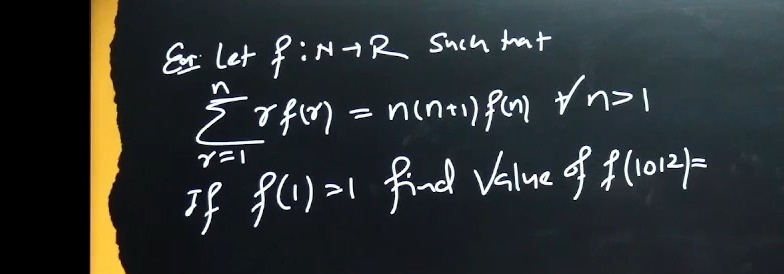Question
Question: Let $f:N\rightarrow R$ such that $\sum_{r=1}^{n} rf(r) = n(n+1)f(n) \forall n>1$ If $f(1)=1$ find V...
Let f:N→R such that ∑r=1nrf(r)=n(n+1)f(n)∀n>1
If f(1)=1 find Value of f(1012)=

The value of f(1012) is 20241.
Solution
Let Sn=∑r=1nrf(r). The given relation is Sn=n(n+1)f(n) for n>1. We also know that Sn=Sn−1+nf(n) for n>1.
For n>2, we can substitute the given relation into Sn=Sn−1+nf(n): n(n+1)f(n)=(n−1)nf(n−1)+nf(n)
Dividing by n (since n>2, n=0): (n+1)f(n)=(n−1)f(n−1)+f(n) nf(n)=(n−1)f(n−1) This gives the recurrence relation f(n)=nn−1f(n−1) for n≥3.
To find f(2), we use the original relation for n=2: S2=∑r=12rf(r)=1⋅f(1)+2⋅f(2). The given relation states S2=2(2+1)f(2)=6f(2). So, f(1)+2f(2)=6f(2). Given f(1)=1, we have 1+2f(2)=6f(2), which simplifies to 1=4f(2), so f(2)=41.
Now we solve the recurrence relation f(n)=nn−1f(n−1) for n≥3: f(n)=nn−1⋅f(n−1) f(n)=nn−1⋅n−1n−2⋅f(n−2) f(n)=nn−1⋅n−1n−2⋅n−2n−3⋯32f(2)
This is a telescoping product, which simplifies to: f(n)=n2f(2) for n≥3.
Substitute the value of f(2)=41: f(n)=n2⋅41=2n1 for n≥3.
Let's check if this formula holds for n=2: f(2)=2⋅21=41, which matches our calculated value. Therefore, the function can be defined as: f(1)=1 f(n)=2n1 for n≥2.
We need to find f(1012). Since 1012≥2, we use the formula f(n)=2n1: f(1012)=2⋅10121=20241.
